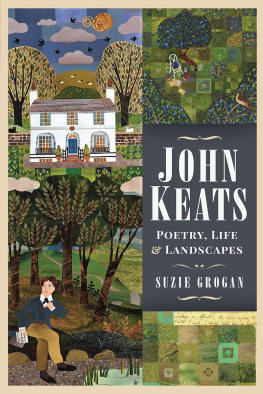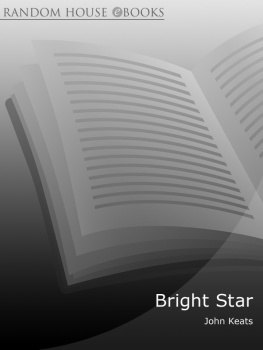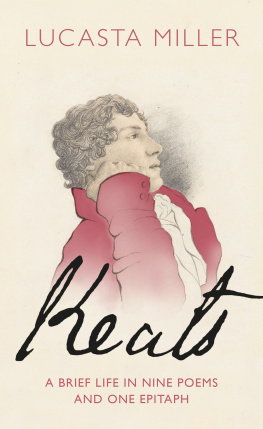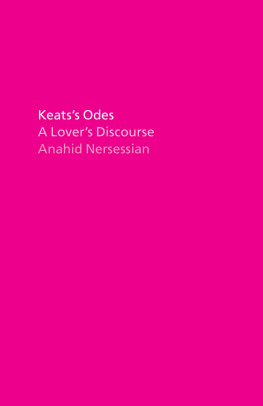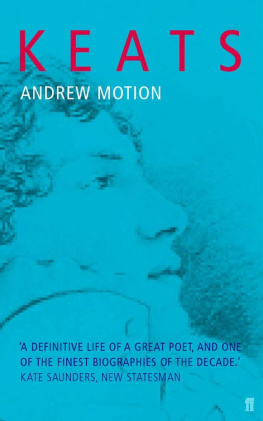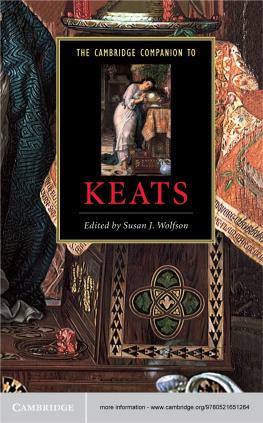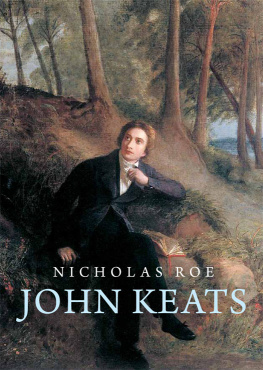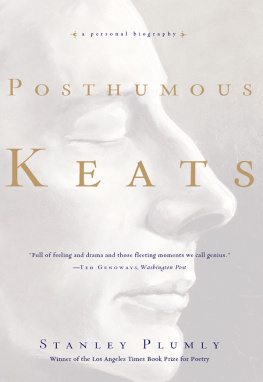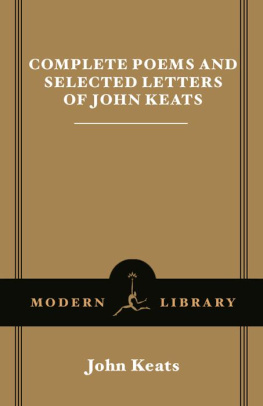Pagebreaks of the print version

JOHN KEATS
JOHN KEATS
POETRY, LIFE & LANDSCAPES
SUZIE GROGAN
First published in Great Britain in 2021 by
PEN AND SWORD HISTORY
An imprint of
Pen & Sword Books Ltd
Yorkshire - Philadelphia
Copyright Suzie Grogan, 2021
ISBN 978 1 52673 937 7
ePUB ISBN 978 1 52673 938 4
Mobi ISBN 978 1 52673 939 1
The right of Suzie Grogan to be identified as the Author of this work has been asserted by her in accordance with the Copyright, Designs and Patents Act 1988.
A CIP catalogue record for this book is available from the British Library.
All rights reserved. No part of this book may be reproduced or transmitted in any form or by any means, electronic or mechanical including photocopying, recording or by any information storage and retrieval system, without permission from the Publisher in writing.
Pen & Sword Books Ltd incorporates the Imprints of Pen & Sword Archaeology, Atlas, Aviation, Battleground, Discovery, Family History, History, Maritime, Military, Naval, Politics, Railways, Select, Transport, True Crime, Fiction, Frontline Books, Leo Cooper, Praetorian Press, Seaforth Publishing, Wharncliffe and White Owl.
For a complete list of Pen & Sword titles please contact
PEN & SWORD BOOKS LIMITED
47 Church Street, Barnsley, South Yorkshire, S70 2AS, England
E-mail:
Website: www.pen-and-sword.co.uk
or
PEN AND SWORD BOOKS
1950 Lawrence Rd, Havertown, PA 19083, USA
E-mail:
Website: www.penandswordbooks.com
To Ann Stone
For her wisdom, her support, and for sharing a love of John Keats
Acknowledgements
My relationship with John Keats, as a poet and as a man, started in my early teens. That is now more than 40 years ago, and in that time I have met many inspirational people who share my enthusiasm for a poet, the bicentenary of whose death, in 2021, has given many the opportunity to look with fresh eyes at his writing in both prose and poem.
When I began this book, it was quite different in form. The Keats Letters and the Keats 200 Projects, alongside the work of the Keats-Shelley Memorial Association, the Keats-Shelley Memorial Association of America, and the ongoing programme offered by Keats House in Hampstead have offered a rich new vein of information for both the academic and independent reader of Keats. I wanted to add a new perspective, and the best way to do that was to use my own. These organisations have also inspired a new appreciation in many who had a fixed idea of the Romantic Keats and who have now been introduced to a very different, more complex and interesting young man, and who now read him with different enthusiasm. Keats has always spoken to a younger generation, as he did to me, and I have been thrilled by the new writing coming from young academics, and many still at school, entering established and new competitions.
It is difficult, then, to single out names, but this book is indebted to the work of Nicholas Roe and Richard Marggraaf Turley, both of whom are at the forefront of Keats scholarship today. Talks they have given and biographical work and articles in books they have edited and published in the last two years have helped support the view I have of my Keats, and have enabled me to feel confident that the man I write about in this book is made real to anyone, from first-time reader to seasoned expert.
On a personal note, I must thank Kim Blank, Professor of English at the University of Victoria, Canada and author of Mapping Keatss Progress (https://www.johnkeats.uvic.ca), a wonderful website packed with information and insight. His willingness to correspond with me in a way that has been nothing but supportive, informative and humorous has been greatly appreciated.
Julie Bozzas Keatss Locations website is also a gem and is especially good on Keatss London haunts. Julie has been good enough to allow me to use some of her own photographs of present-day Keats locations in this book.
I must also thank the interesting people of the Keats community on Twitter along with the Twitter feeds of the Keats-Shelley Memorial Association, the Keats-Shelley Association of America and the Keats Foundation. It is a place where ones passions can be expressed, ones thoughts discussed and ones mistakes corrected. I have found it invaluable. It is Dr Lynn Shepherd at The Wordsworth Trusts wonderful Romanticism blog, however, who has offered me most, including the opportunity to write for the blog a number of times and endless confidence boosts along the way. She is one person I can never thank enough.
I must also mention Ann Stone, Stephanie Matthews, Wendy Mewes and Jane Thomas, without whom this book would genuinely not have been written. In different ways, they have kept me going, even when my doubts were greatest. They are my four wise women and I am grateful to each of them.
Sincere thanks are also due to Chris Grogan, Carol Trow and Andrew Weltch who have worked so diligently on copy editing and proofreading the text.
Much of this book has been supported by my Carlyle Membership of The London Library, for which I am endlessly grateful. Apart from being a wonderful place to study and write when in London, it has offered me the opportunity to access journal articles online. Even if my style is informal, I like to think it is backed up by study and research.
As this book was completed during a period of lockdown, due to the COVID-19 virus, I am indebted to the Society of Authors for providing me with a grant from the Authors Contingency Fund. The grant enabled me to retain online subscriptions and memberships giving access to important papers.
The staff at Keats House in Hampstead, over the many years of my visits, have given me the greatest access to the originals of Keatss letters and poems in his own hand, sight of The Keats Collection, including precious mementoes kept lovingly by friends and relations and a sense of Keats in the real world. It is the real man, the world he lived in and the experiences he had that shaped his work and over the years much of it would have been lost without the work at the House and in the Keats-Shelley House in Rome, which I have also had the privilege to visit. Most recently I spent valuable time with Chief Curator Rob Shakespeare and Ken Page, the Interpretation Officer at the Hampstead house.
Many thanks also to everyone at publishers Pen and Sword for their support, especially Heather Williams, who was willing to allow a more personal approach to Keats.
A quick note on the text in quotations from Keatss letters I have used the original punctuation, spelling and capitalisation as printed in H.E Rollins, ed., The Letters of John Keats (Harvard University Press, 1958). The poems are arranged according to Jack Stillinger, ed., Keats, John, Complete Poems (Harvard University Press, 1982).
Finally, I must thank my lovely husband Peter who has not only supported me through the stresses of the writing life over the years but has put up with there being three people in this marriage. Without Peter, even Keats could not have saved me.
Suzie Grogan
Brittany, October 2020
Foreword
It was Keats who brought Suzie and me together; I suspect he does that a lot. In our case, it was through the Romanticism blog, which I set up in 2014 when I was a trustee of the Wordsworth Trust. Suzie was one of our first Twitter followers, and shortly afterwards one of our earliest contributors, with a delightful post about her lifelong passion for Keats, and the special power of his beautiful sonnet, When I have fears that I may cease to be a post thats still eliciting comments and retweets even now. Since then Suzie has reviewed for us, written on Keatss medical training, looked at his contemporary portraits, and helped readers discover modern interpretations of his work. Each piece equally thoughtful, well-researched, and extremely readable. Hers are also among our most popular posts, and thats not just down to the quality of the writing (though thats definitely a factor). There is, as they say, something about Keats.

